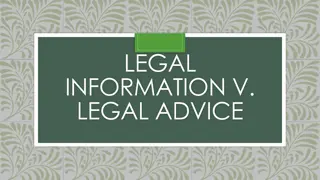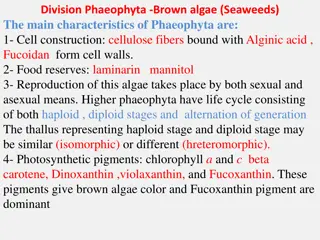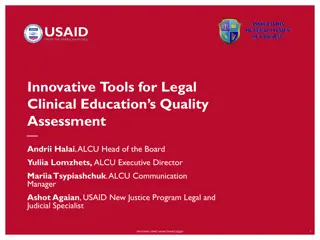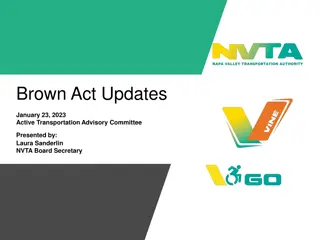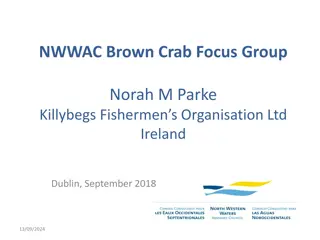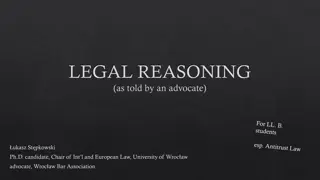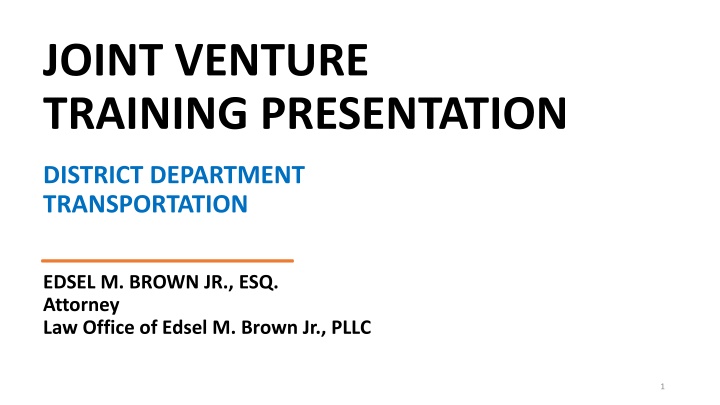
Joint Venture Operations in the District of Transportation
Gain a fundamental understanding of joint ventures, key considerations for entering into a JV relationship, alternative options, and operating a JV in DC. Explore the significance of pooling resources, developing new products, accessing new markets, and mitigating risks. Learn about due diligence in terms of promised contributions, competing businesses, and existing loan documentation to ensure successful joint venture outcomes.
Uploaded on | 2 Views
Download Presentation

Please find below an Image/Link to download the presentation.
The content on the website is provided AS IS for your information and personal use only. It may not be sold, licensed, or shared on other websites without obtaining consent from the author. If you encounter any issues during the download, it is possible that the publisher has removed the file from their server.
You are allowed to download the files provided on this website for personal or commercial use, subject to the condition that they are used lawfully. All files are the property of their respective owners.
The content on the website is provided AS IS for your information and personal use only. It may not be sold, licensed, or shared on other websites without obtaining consent from the author.
E N D
Presentation Transcript
JOINT VENTURE TRAINING PRESENTATION DISTRICT DEPARTMENT TRANSPORTATION EDSEL M. BROWN JR., ESQ. Attorney Law Office of Edsel M. Brown Jr., PLLC 1
WHAT ARE WE LOOKING TO ACCOMPLISH? Fundamental understanding of what is a JV Key considerations in deciding whether to enter into a JV relationship JV alternatives Key considerations in developing and operating a JV in DC 2
WHAT IS A JOINT VENTURE? A joint venture is a combination of two or more parties that seek the development of a single enterprise or project for profit, sharing the risks associated with its development. The parties to the joint venture must be at least a combination of two natural persons or entities. The parties may contribute capital, labor, assets, skill, experience, knowledge, or other resources useful for the single enterprise or project. *Legal Information Institute 3
PRE-JOINT VENTURE CONSIDERATIONS Why enter into a JV relationship: -pool resources -develop new products -access new markets -less capital/risk than an outright M & A 4
PRE-JOINT VENTURE CONSIDERTIONS DUE DILIGENCE Promised Contributions to the JV: -Does the party have title to the assets promised? -Does the party have the expertise needed? -If party has committed to make a future capital contribution, what are the sources of capital? 5
PRE-JOINT VENTURE CONSIDERATIONS DUE DILIGENCE Competing Businesses: -Does the party have duties or obligations to its existing business which will potentially deprive the joint venture of opportunities. -Are there non-compete or other restriction in place with respect to the existing business which will hamper the JV in any way Existing Loan Documentation: -Are there negative covenants in loan or other documents limiting JV participation. 6
Due Diligence Essential to identifying assets, liabilities, and operational needs PURPOSE JV TRANSACTION SPECIFIC ISSUES GENERAL CONSIDERATIONS Due diligence is specific to the purpose and scope of the JV Determine value of participant contributions Quantify business risk and issues that impact value or JV purpose Identify required regulatory and third-party notices/consents/ approvals Discover red flag issues (i.e., potential successor liability concerns) Confirm ownership and transferability of contributed assets Contract assignability Encumbrances Identifying contributed assets and need for shared/leased services Potential tax implications of JV structure Level of detail to asset and liability listings Clearly understand the business objective and verify JV will satisfy that strategic objective Consider mechanics to exit JV Logistics and workstreams (i.e., scope, timing, cost sensitivity) Scope of due diligence Format of deliverables and privilege issues Updates to schedules between signing and closing (if applicable in the principal JV agreement) Ancillaries needed for operating the JV after its formation Accounting and tax matters 7
PRELIMINARY AGREEMENTS Letters of Intent (LOI) or Term Sheets: -Used to establish a common understanding of the basic terms of the transaction and to facilitate negotiations. Sets forth important terms of the proposed joint venture. It is often one of the first documents prepared in connection with a transaction, before a full-fledged legal, tax, and accounting due diligence investigation commences, and before time intensive and costly drafting of definitive documents begins. Key benefits of an LOI or Term Sheet: -Defines key terms and facilitates negotiations, expedites the drafting process, identifies potential deal-breaking issues, measures good faith, secure financing, expedite regulatory waiting periods, focuses the due diligence process, and improves deal certainty. 8
PRELIMINARY AGREEMENTS Confidentiality Agreement: -Parties to a potential joint venture will likely exchange confidential or proprietary nonpublic business and financial information over the course of negotiations. Therefore, it is important to have a confidentiality agreement in place early in the transaction process to govern the parties use a disclosure of such information. Important Items to Consider in Drafting a Confidentiality Agreement: -The kinds of information that will be exchanged between them -How such information may or may not be used by each party -Whether to include non-solicits or non-hires of customers, suppliers, or employees, and -How long the confidentiality obligations should last 9
Preliminary Agreements NON-DISCLOSURE AGREEMENTS TERM SHEET/LOI/MOU Mutual/bilateral Avoid broad definitions of Confidential Information and Representatives Limited permitted disclosure (flexibility to disclose to advisors and other internal parties) Return and destroy provisions (avoid unduly burdensome obligations) Survival of obligations Remedies and procedures for breach Identify and outline scope and purpose of JV Propose JV structure Key terms (e.g., management, exit strategies, contributions, profit sharing) Binding vs. non-binding 10
JOINT VENTURE STRUCTURES Joint Venture Structures Overview: -A JV may be set up through a contractual relationship among the parties by the formation of a new entity (i.e. corporation, partnership, or limited liability company in which each joint venture party holds an interest. 11
JOINT VENTURE STRUCTURES CONTRACTUAL JV Instead of forming a separate legal entity, the parties can enter into a contract setting forth the terms of the joint venture. In such an arrangement, the parties' rights and obligations would be determined solely with reference to the contract. Some of the benefits of a contractual joint venture include the following: -Clear division of assets and liabilities. -Clear ownership of products and revenues. -No joint and several liability. Liability is never joint and several unless specifically provided for under the terms of the agreement. -Flexible terms and ease of exit. 12
JOINT VENTURE STRUCTURES JOINT VENTURE ENTITIES Instead of forming a JV via a Contract keeping the parties separate, the parties may select forming a formal separate entity. The varying organizational entities that can be formed are as follows: CORPORATION The forming of a JV as a corporation can have tax benefits if the venture is expected to generate independent profits. Additionally, a corporation provides liability protection to the venture parties. A corporation also requires maintenance in the form of corporate filings and other organizational matters. 13
JOINT VENTURE STRUCTURES JOINT VENTURE ENTITIES PARTNERSHIPS If JV is expected to generate losses, the tax benefit of those losses can be passed through to the parties in a partnership structure. Partnership parties are exposed to liability, especially if the partnership is a General Partnership or one of the parties serves as the General Partner. LIMITED LIABILITY COMPANY (LLC) LLCs provide the management flexibility of a partnership with the limited liability of a corporation and the tax benefit of either a partnership or corporation (as the parties decide). Also have few legal requirements. 14
Joint Venture Structures The different types of JV structures No legal entity established, only a written or oral contract between parties Ownership of assets retained by contracting parties Liability shared by contracting parties (subject to indemnities) No fiduciary duties CONTRACTUAL No legal entity established, only a written or oral partnership agreement between parties (general partnership if oral) May be created by operation of law if elements of JV are satisfied Assets may be contributed to/owned by the partnership Liability and fiduciary duties based on type of partnership PARTNERSHIP Corporation formed Assets contributed to/owned by the corporation Liability is limited and fiduciary duties apply Board of directors / shareholder rights CORPORATE ENTITY LLC formed Assets contributed to/owned by the LLC Liability is limited and fiduciary duties may apply Manager/member-managed LIMITED LIABILITY COMPANY 15
FORMING A CONTRACTUAL JOINT VENTURE IN DC BENEFITS: -If one or more of the businesses associated in a joint venture is a certified business enterprise ( CBE ), the joint venture may qualify to be certified under the Department of Small and Local Business Development s CBE program. HOW IS CERTIFICATION OF A JV DETERMNED/TIMELINE: -The Department of Small and Local Business Development ( DSLBD ) determines the eligibility of a joint venture for certification on a contract-by contract basis. Usually takes 1-3 weeks 16
FORMING A CONTRACTUAL JOINT VENTURE IN DC WHAT IS A CERTIFIED BUSINESS ENTERPRISE : -It is a business headquartered in the District of Columbia and certified by the Department of Small and Local Business Development (DSLBD). Businesses with CBE certification receive preferred procurement and contracting opportunities. 17
FORMING A CONTRACTUAL JOINT VENTURE IN DC CBE CRITERIA: -The principal office of the business must be physically located in the District of Columbia; -Meets one of the following standards: -Independently owned, operated, and controlled; or -More than 50% owned, operated, and controlled by a District-based enterprise or not-for-profit business; or -Owned by a non-District-based business enterprise or not-for-profit business that is more than 50% owned by District residents; -Chief Executive Officer and highest-level managerial employees of the business enterprise must perform their managerial functions in their principal office located in the District; 18
FORMING A CONTRACTUAL JOINT VENTURE IN DC CBE CRITERIA: -Meets one of the following four standards: -More than 50% of the employees of the business are residents of the District; or -The owners of more than 50% of the business enterprise are residents of the District; or -More than 50% of the assets of the business, excluding bank accounts, are in the District; or -More than 50% of the business gross receipts are District gross receipts 19
FORMING A CONTRACTUAL JOINT VENTURE IN DC HOW DO YOU APPLY TO HAVE A JV CERTIFIED: -To apply for certification of a joint venture, the following documents must be submitted to the Department of Small and Local Business Development for review: -Signed agreement between companies that contains all necessary requirements. -Labor & profit breakdown spreadsheet -Work performance breakdown spreadsheet -Non-CBE financial statement 20
FORMING A CONTRACTUAL JOINT VENTURE IN DC Code of the District of Columbia 2 218.39a. Certified joint venture 21
FORMING A CONTRACTUAL JOINT VENTURE AGREEMENT IN DC EXECUTED JV AGREEMENT MUST INCLUDE THE FOLLOWING REQUIREMENTS: -Specifies in reasonable detail the purpose(s) of the joint venture; -Identifies the specific procurement, solicitation, or project the applicant wishes to be certified to fulfill; and -Identifies the parties of the joint venture and defines their respective obligations and responsibilities; -Provides for the establishment and administration of a separate bank account in the name of the JV, and requires all deposits and withdrawals to be signed by all members. 22
FORMING A CONTRACTUAL JOINT VENTURE AGREEMENT IN DC EXECUTED JV AGREEMENT MUST INCLUDE THE FOLLOWING REQUIREMENTS: -Contains an itemized description of all major equipment, facilities and other resources to be furnished by each participant in the JV management committee. -Specifies the responsibilities of the parties in at least the areas of negotiations with owners, subcontract negotiation, contract and subcontract performance. -Contain a provision indicating the CBE s interest in the VJ shall not be reduced or diluted. 23
FORMING A CONTRACTUAL JOINT VENTURE AGREEMENT IN DC EXECUTED JV AGREEMENT MUST INCLUDE THE FOLLOWING REQUIREMENTS: - Provides that the certified business enterprise participant will exercise more than 50 percent of the control over contract performance, including the manner in which contract specifications will be completed, day to day operations will be carried out, personnel decisions, employees will be managed, equipment supplies will be purchased. -Contain a provision indicating that the joint venture agreement is the controlling agreement between the parties regarding interest, ownership, control, responsibilities, duties, and functions of the parties and that the JV agreement shall prevail if there is any conflict between any other agreement. 24
FORMING A CONTRACTUAL JOINT VENTURE AGREEMENT IN DC EXECUTED JV AGREEMENT MUST INCLUDE THE FOLLOWING REQUIREMENTS: -Contain a provision indicating the CBE s financial risk is commensurate with its percentage interest in the join venture. -Contain a provision indicating that the CBE s financial risk is commensurate with its percentage interest in the JV -Indicate that the CBE shall perform services of the JV, receive profits or the JV, provide labor hours required of the JV, or perform other work for the JV as approved by the Department that is at a minimum equal to its percentage of ownership in the JV. 25
FORMING A CONTRACTUAL JOINT VENTURE AGREEMENT IN DC EXECUTED JV AGREEMENT MUST INCLUDE THE FOLLOWING REQUIREMENTS: -Demonstrate that an applicant for or holder of an CBE certification is one of the joint venturers (an application for joint venture certification may be submitted to and reviewed by DSLBD simultaneously with an application for certification of the individual CBE) -Inform DSLBD whether the CBE has relinquished its ownership in any JV within the one year period prior to application date. -Submit to DSLBD the most current audited financial statement for the non-CBE participant 26
FORMING A CONTRACTUAL JOINT VENTURE AGREEMENT IN DC EXECUTED JV AGREEMENT MUST INCLUDE THE FOLLOWING REQUIREMENTS: -Demonstrate that the CBE participant in the joint venture has the competence and expertise necessary to perform the contract for which the applicant is seeking certification, but lacks the necessary capacity to independently perform the contract due to factors which may include inadequate financial or technical resources or an inability to secure sufficient bonding, -Permit DSLBD to enter and conduct an onside inspection or reinspection of the applicant s business premises. 27
DEVELOPING A CONTRACTUAL JOINT VENTURE AGREEMENT IN DC AVOIDING PARTNERSHIPS: -In order to avoid the inference of a partnership, and the resulting joint and several liability of the participants, the JV agreement should be drafted in a manner that emphasizes the separation and independence of the participants businesses. The parties should maintain separate operational control and the agreement should provide for the separate accrual and taxation of profits. Things to consider to avoid Partnership consideration: -The business of the JV is not operated in common -No participant in the JV has the authority to bind any other participant -The participants will not be jointly and severally liable for the JV debts/liabilities -There is no legal or joint ownership of any assets used by the JV -Each party will be responsible for the acts and conduct of its employees/agents 28
DEVELOPING A CONTRACTUAL JOINT VENTURE AGREEMENT IN DC INDEMNIFICATION: -The parties will likely want to include indemnification provisions in the agreement to cover potential third party claims attributable to acts, omissions and/or breaches of the other party. The issue may be of particular importance in project based JV agreements, where underlying contracts with third-party clients usually hold all JV participants jointly and severally liable for any breaches by the JV or any individual participant. DURATION: -Contractual JV relationships are usually for a limited duration. Frequently these agreements are such that the term starts when the agreement has been signed by all the parties and terminates when the project is completed. 29
DEVELOPING A CONTRACTUAL JOINT VENTURE AGREEMENT IN DC CONFIDENTIAL INFORMATION: -In light of the collaborative nature of JV relationships, in many instances participants will be provided with or have access to sensitive and proprietary information of the other participants during the term of the agreement. Access to a party s customers or vendors may also be necessary to accomplish the JV s mission. Each party will therefore want to ensure that its confidential information is protected from improper use. A confidentiality agreement therefore should be in place before any disclosure of confidential information is shared. RESTRICTIVE COVENANTS: -Any restrictions on the JV participants right to compete against the JV should be carefully drafted and included in the agreement. The parties may desire terms that preclude them from engaging in activities that directly compete with the business of the JV. 30
DEVELOPING A CONTRACTUAL JOINT VENTURE AGREEMENT IN DC STANDARD CONTRACTUAL JV PROVISIONS: -Limitation of Liability -Force Majeure -Choice of Law -Choice of Forum -Waiver -Integrated Agreement 31
DEVELOPING A CONTRACTUAL JOINT VENTURE AGREEMENT IN DC EXIT AND TERMINATION PROVISIONS: -Effect of Termination: -The JV agreement should set out the effect of a termination, regardless of the cause. Termination usually involves allocating any profits or losses along agreed lines and taking into account any relevant indemnities and any other post termination obligations that might exist. Termination provisions should address the parties respective rights and obligations, including ownership and use of rights of any JV assets, any post termination restrictive covenants, any obligations to support any customers, and the resolution of any existing or potential liabilities of the JV. 32
DEVELOPING A CONTRACTUAL JOINT VENTURE AGREEMENT IN DC EXIT AND TERMINATION PROVISIONS: -In light of the short term nature of most contractual JVs and the crucial role that each party s contribution plays in the success of the project, the expectation is usually that each party will remain in the project until it is concluded. It is thus unusual for a party to have the right to voluntarily exit from a contractual JV before it comes to its natural conclusion. These JVs may be for a finite duration with a predetermined expiration date or may automatically terminate upon the occurrence of a designated event, such as completion of the project. -Other Considerations: -Termination for convenience -Insolvency or change of control 33
ADDITIONAL REQUIREMENTS TO GETTING A DC JOINT VENTURE APPROVED -Executed Addendum to the JV Agreement; -Work performance and Labor and Profit breakdown spreadsheet; -Resumes for the key personnel of the joint venture; -The most current audited or reviewed financials for the non-CBE member(s); -The most current audited or reviewed financials for the non-CBE member(s); -Documentation demonstrating past project performance of the businesses within the JV. Each member must demonstrate that the JV has the competence and expertise necessary to perform the type of work in connection with the opportunity the joint venture wishes to be certified (i.e. list of past or current projects that are similar to the project scope of the opportunity the JV wishes to pursue); - 34
ADDITIONAL REQUIREMENTS IN GETTING A DC JOINT VENTURE APPROVED -Proof of bonding capacity for each member of the JV (i.e. letter from the bonding company that details on a single level what each party can bond). The CBE partner needs to demonstrate the ability to bond the percentage of the contract amount that is commensurate to their percentage interest in the JV (e.g. a 51% joint venture member needs to demonstrate the ability to bond at a minimum 51% of the contract amount) if applicable; -The bid bond (in the name of the JV) - if applicable; -A copy of the solicitation the JV wishes to pursue; and 35
ADDITIONAL REQUIREMENTS IN GETTING A DC JOINT VENTURE APPROVED -Any other agreements between the parties regarding the operations of the JV. *A certificate issued to a JV shall be nonrenewable and nontransferable and shall expire upon the completion or termination of the contract or any extensions thereof. 36
OPERATING THE JOINT VENTURE JV OPERATES IN LINE WITH THE THIRD PARTY AWARD REQUIREMENTS AND PROVISIONS OF THE JV CONTRACTUAL AGREEMENT: -Additional agreements may be needed to effectively operate the JV: -Branding and marketing agreements -Business opportunity agreements -Supply and distribution agreements -Service agreements 37
QUESTIONS 38
Edsel M. Brown Jr., Esq Attorney 1629 K Street, N. W. Suite 300 Washington, D. C. 20006 (202) 329-1520 emb@edselmbrownjrlaw.com emb@edselmbrownjrlaw.com www.edselmbrownjrlaw.com www.edselmbrownjrlaw.com 39


